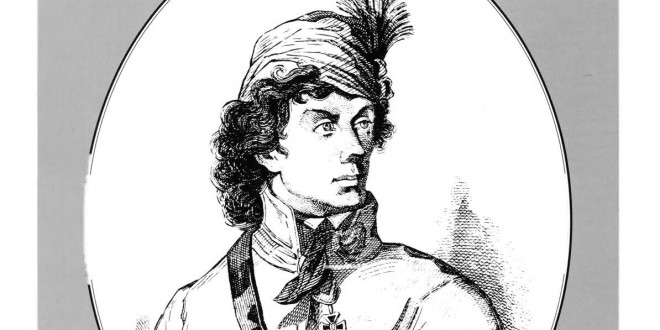by Albert Cizauskas
Soldier, Humanitarian, Lithuanian
“Lithuania — My fellow countrymen and compatriots1. I was born on your soil and in my ardor for my homeland there is within me a special inclination toward those among whom I began my life… Lithuania — Glorious for valor and citizenship… I vow to stand amidst you!.”
Kosciusko, in a proclamation to Lithuanians (1794)
ONE OF LITHUANIA’S GREATEST HEROES is, ironically, one of its least known and honored. This neglect was not always so. When Thaddeus Kosciusko (Tadas Kosciuška in Lithuanian; Tadeusz Kosciuszko in Polish) died in 1817, Lithuanians held memorial services throughout the country and petitioned the Czar for the body of their “fellow Lithuanian” in order to erect a monument in his honor. Unfortunately, the Czar denied this request but allowed Poles to bury him in Cracow as their national hero.
After a brilliant career in the American Revolution, Kosciusko led the old Polish-Lithuanian Commonwealth in its last organized resistance to Russia. His leadership in two short but brutal campaigns against the forces of Russia’s Catherine the Great, assisted by Prussia and Austria, earned him the fervent gratitude of the Poles, and originally, also of Lithuanians.
Today, however, Kosciusko is all but forgotten by Lithuanians. The Poles instead have monopolized his memory, erecting an imposing memorial to him across from the White House and in other places throughout the United States. In addition, Poles have written innumerable books and articles on this unusual man, many in English. On the other hand, not one scholarly work devoted exclusively to Kosciusko can be found in Lithuanian, and only an occasional article in English written by Lithuanians.
No clear answer for this puzzling apathy is forthcoming from Lithuanians, except a sort of shrug that the man did little for Lithuania, or that he was more of a Pole than Lithuanian. The truth is more complex. At several times in his career, Kosciusko publicly acknowledged his Lithuanian origins, although, in common with the upper classes in Lithuania at the time, his first language was Polish and his primary allegiance was to the PolishLithuanian Commonwealth, a federation of two juridically equal but separate countries. It is not surprising, then, that Kosciusko is often identified as a Pole, but it is surprising that Lithuanians seem to have abandoned legitimate claims to one of their most illustrious sons.
It is also unfortunate that so much about him is either unknown or misunderstood by present-day Lithuanians. This, however, is true of Americans as well, even though Kosciusko was one of the few authentic foreign heroes of the American Revolution. John Quincy Adams, America’s sixth President, eulogized him in a biography, praising Kosciusko as “one of the two most eminent foreigners” to fight for American independence (the other being Lafayette). In his day, Kosciusko was a world-wide celebrity, the idol of Western liberals. He was a close friend of Thomas Jefferson for over 20 years, was praised in adulatory verse by major English poets — Byron, Keats, Coleridge — , and was followed by large crowds wherever he went,in Europe and America.
Why this enthusiasm for a man who, while successful in the American Revolution, had been defeated in his own country? The answer is simple. He captured the public’s imagination as the champion of the underdog, first against the British in America, then against Czarist Russia, one of history’s most repressive regimes. These achievements have been sufficient to assure Kosciusko an honorable place in history. Obscured, however, by the romantic appeal of his military exploits, Kosciusko’s belief that political freedom and social justice cannot exist one without the other, is of far greater significance. Kosciusko acted on this belief in his lifelong advocacy of the freedom, education and economic independence of American slaves and European serfs at a time when such notions were even more radical than the principles of Jefferson’s Declaration of Independence. It is this message that speaks to us today in our divided world, a message that transcends the claims of nationalism.
“I, Thaddeus Kosciusko, formerly an officer of the United States of America, and a native of Lithuania…”
— Kosciusko, in a codicil to his last will and testament, written in Paris (1798).
Early Life
Kosciusko was born February 12th, 1746, of Lithuanian-Ruthenian stock near present-day Brest-Litovsk (Lietuvos Brasta) when that area was part of the Grand Duchy of Lithuania. It is an interesting historical coincidence that the 12th of February is also the date of Lincoln’s birth, since both men shared similar social ideals. Showing early promise, Kosciusko was sent to Paris on a royal stipend to further his education. It was undoubtedly here that the young and idealistic student was influenced by the French Enlightenment with its emphasis on human perfectibility and the rights of man.
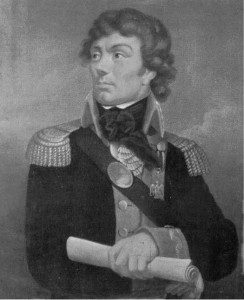
Upon his return, Thaddeus, a younger son in an impoverished family of the lesser nobility, accepted the post of tutor to the children of a wealthy and highly-placed noble. He was then 28 years of age, restless with an ambition which found no outlet in an unsettled country dominated by Russia. It was no surprise, then, that the tutor quickly fell in love with one of his charges, the lively and lovely Ludvika Sosnowska. Thaddeus, sensing that Ludvika’s father would not accept a suitor with little prospects, persuaded her to elope with him to the American Colonies, whose struggle had fired the enthusiasm of the young idealist. The romantic couple, however, was pursued and Ludvika forcibly returned to her father who married her off to a fellow aristocrat. The episode implanted in the rejected suitor a deep scorn for social pretense and class inequality.
The American Experience
Thaddeus proceeded alone to the Colonies and offered his services to the American cause at a time of military reverses. It was August of 1776, a month after the Declaration of Independence had transformed an uncertain rebellion into a revolution. The young engineer was immediately put to work shoring up Philadelphia’s defenses against the British who had taken New York and were threatening the Pennsylvania city. This he did so well that he was awarded a commission as colonel of engineers. As such, he performed services which had an important bearing upon the successful outcome of the fight for independence.
The most notable was his role in the decisive battle of Saratoga where his fortifications led to the first major victory for the Americans and assured them of open French support. Another was the erection of defenses at West Point to prevent British attempts to split the Colonies. Subsequently, he was instrumental in founding the young nation’s military Academy at West Point for which he wrote a treatise of the deployment of horse artillery. Grateful cadets raised the first monument on the Academy’s grounds to honor the “eminent” foreigner who had done so much to secure freedom for their country. In a final service, he successfully employed his engineering prowess to push the British out of the Carolinas and into Virginia where they were ultimately forced to surrender and end the war.
After the war, Congress recognized the importance of Kosciusko’s services by awarding him the brevet rank of brigadier general, a grant of land in the Ohio territory where the city of Columbus now stands, and a special resolution of thanks.
A Humanitarian Soldier
Returning home, Kosciusko spent several relatively uneventful years on the family estate in Lithuania. Here he had the first opportunity to put his humanitarian impulses to a practical test. In a highly unusual step for a member of the land-owning class, Kosciusko reduced by half the compulsory labor for men, and abolished it entirely for women, among the serfs on his own estate.
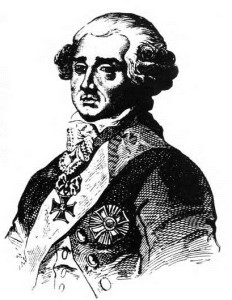
as general of his army, but a few short years later lost his crown and became known as the last king of Lithuania and Poland.
Five years after his return, in 1789, the uneasy relationship between Russia and the Commonwealth was fast approaching the point of no return. The king, anticipating a break in relations, appointed Kosciusko as major general, partly in deference to the latter’s American military reputation and partly owing to Ludvika’s influence, now the Princess Lubomirska.
Kosciusko’s appointment resulted in one of the most dramatic chapters in the troubled history of the PolishLithuanian union. His leadership inspired an emotional response from all classes. Numerous battles were waged, in some of which Kosciusko routed superior Russian forces. The lower classes were the backbone of Kosciusko’s armies, and they fought, at times only with scythes, with the traditional fury of peasants when aroused. The lack of adequate firepower, as well as material support from sympathetic countries such as France, doomed Kosciusko’s brilliant resistance from the start. He was finally beaten, seriously wounded and imprisoned at St. Petersburg.
It was as military head of the Commonwealth in 1794 that Kosciusko enunciated his political and social philosophy. Influenced by Jefferson’s Declaration of Independence, Kosciusko proclaimed an “Act of Insurrection” in both Polish and Lithuanian, in which he called upon all the people of both countries, aristocrats and gentry, peasants and townspeople, to drive out the foreigners occupying their lands. He justified the Insurrection in the spirit of the American Declaration by citing his country’s grievances and assuring the people of their undeniable right to resist tyranny and armed conquest.
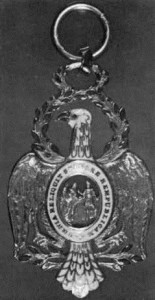
Kosciusko received from George Washington for his service to the American cause.
But Kosciusko had in mind more than political liberty. He followed up the proclamation for armed resistance with a promise to abolish serfdom throughout the Commonwealth. Then, in the pragmatically idealistic conviction that, in his own words, “Liberty alone does not provide for the peasant and his family”, he also promised the peasants the right to own their own land. With these covenants to the nation, Kosciusko had publicly defined the essence of his legacy to us: that political freedom is a necessary precondition of social justice and that social justice is not possible without the means to sustain it.
Kosciusko, in effect, was preaching a political and social doctrine that was far more revolutionary than even that of the American revolutionaries. It was a doctrine that was even more revolutionary than that of the former Soviet Union which denied political freedom as the price for social justice and ended up by denying both.
A Hero of Two Worlds
Kosciusko was freed after two years and proceeded in slow stages to America, the scene of his earliest triumphs. He travelled via Finland, Sweden and England, and was tumultuously welcomed everywhere. Interestingly, the British had overlooked Kosciusko’s role against them in their enthusiasm for his gallant stand against Czarist Russia.
When he reached Philadelphia in the summer of 1797, then the republic’s capital, throngs of Americans cheered him at dockside, and unhitched his carriage to pull him to his lodgings. The house where he lived during his American visit (at Third and Pine Streets), is now an historic shrine maintained by the National Park Services.
He was warmly welcomed by the leaders of the young nation, including Washington. But the American who became his closest friend was Thomas Jefferson. This reflects well on both men whose philosophic outlook was much the same. An intimate correspondence between the two for more than 20 years attests to the congenial nature of their relationship. Jefferson wrote of Kosciusko at this time: “I see him often and with great pleasure… He is as pure a son of liberty as I have ever known, and of that liberty which is to go to all, and not to the few or rich alone.”
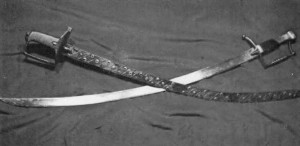
One of the most revealing and touching acts of Kosciusko’s long career took place at the time of his departure from America. He then willed to his good friend Jefferson all the money he had earned during the Revolution for Jefferson to purchase not only the freedom of black slaves, but also to finance their education. This was at a time when Jefferson, although an enlightened man, was still a slave owner. It demonstrates Kosciusko’s firm conviction that political liberty was a right that is color blind and that education is an essential ingredient of political liberty.
“I was born in Lithuania, and have but a few years to live; nevertheless the veil of the future still covers the destiny of my homeland…”
-Kosciusko, in a letter to Czar Alexander I (1813).
Final Years
osciusko left America for France in the hope that Napoleon, then the master of Europe, would espouse the cause of Poland and Lithuania. He was soon disillusioned, however, by Napoleon’s lust for conquest and realized that no help would be forthcoming from that quarter. Nevertheless, on the eve of his first campaign against Russia in 1806, Napoleon tried to enlist Kosciusko’s support. Napoleon appreciated Kosciusko’s moral authority among the latter’s countrymen and hoped thereby to win over the help of the Poles and Lithuanians against Russia. Kosciusko, however, prudently requested concrete assurances beforehand from Napoleon that the Commonwealth be restored to its original boundaries and that the peasants be liberated and permitted to own their own lands. Needless to say, Napoleon regarded Kosciusko’s demands as “pie in the sky” and declined even to respond.
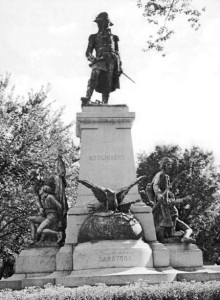
Following Napoleon’s defeat, the Russian Czar, Alexander I, also sought Kosciusko’s support for Russian policies affecting Poland and Lithuania. Kosciusko confronted the Czar with the same set of conditions and met with the same refusal. This time, however, Kosciusko broadened his request by including free education for the peasants at the expense of the state. Kosciusko appreciated earlier than most of his European contemporaries that freedom could not be sustained without education, the basis for a skilled and alert citizenry.
When it appeared that the Czar was prepared to set up a separate Kingdom of Poland, albeit much reduced and under Russian sovereignty, Kosciusko addressed one last appeal to Alexander in which he publicly identified himself as a Lithuanian and sought at least comparable treatment for the land of his birth. Once again, there was no reply. Disillusioned by the turn of events, Kosciusko retired to Switzerland where he died in 1817. Before his death, however, he granted complete freedom to the serfs on his Lithuanian estate whose obligatory services he had earlier mitigated. For the last time, the Czar thwarted Kosciusko and denied the humanitarian gesture of a dying man.
“Will you allow me to return to Lithuania?… Who then am I, if none other than a Lithuanian, a friend of yours… You have chosen me… Whom should I defendf if not you and myself?… Lord knows anger seizes me when I think, that 1, being a Lithuanian, must serve Poland. ”
—Kosciusko, in a letter to General Juozas Niesiolovskis, Commander of the Lithuanian Army, after the Lithuanian-Polish Seimas (Parliament) had sent Kosciusko to serve in Poland (1790).
The Question of Kosciuška’s Origin
IT IS BELIEVED THAT THE KOSCIUŠKA FAMILY WAS STARTED at the end of the 15th century or the beginning of the 16th by a man named Theodore, who is said to have been King Aleksandras’ (1492-1506) clerk. King Žygimantas The Elder (1506-1548) granted Theodore’s son Constantine ownership of the Siechanaviciai estate, located near the village of Merecovscizna, in Lithuania’s Naugardukas (Nowogrodek) province. Constantine married the Lithuanian princess Anna of the old and prestigious ducal family of Alšenai. As family surnames became established in the 16th century, their descendants came to be called Kosciuška. The estate of Siechanaviciai became the nucleus of the entire Kosciuška family during the next centuries. Its relation with the Alšenai family made it rise to the class of the higher nobility. Later, Lithuania’s wars with Russia depleted the family’s wealth so much that by the beginning of the 18th century it became impoverished. It is said that the family became so poor that when one of its members died, he left only a silver spoon and a belt with a silver buckle in his last will and testament.
While it is true that Tadas Kosciuška served as an army officer in Poland (also in Lithuania and America), no proof of his alleged Polish extraction can be found in any reliable source. Leonard Chodzko (Leonardas Chodzka), the renown historian, publicist, and author of the first biography of Kosciuška, in his new edition of Malte Brune’s Tableau de la Pologne, Anciene et Moderne, published in Paris in 1831 (a mere 14 years after Kosciuška’s death), stated: “The whole world was witness to the heroism which the Lithuanians displayed in the campaigns of 1792 and 1794, against foreign rapacity, when Kosciuszko, a Lithuanian by birth, covered with imperishable laurels the chains of Poland/’ And the respectable historian and author M. Charles Forster, former Secretary of the Kingdom of Poland, recipient of numerous awards, and member of the prestigious Historical Institute, the Philotechnic Society, and the Atheneum of Arts in Paris, in his Pologne (a history of Poland), published in 1840, wrote: “Descended from an ancient Lithuanian family, Kosciusko was born at Merecovscizna on February 16, 1746.” (For some unknown reason, all later sources mention February 12 as Kosciuška’s day of birth -V.R.) But in 1967 — 127 years later — Stephen P. Mizwa, in his Great Men and Women of Poland, published by the Kosciuszko Foundation of New York, states: “A Polish national hero and the American Revolutionary War patriot, Tadeusz Kosciuszko was born in the village of Mereczowszczyzna near Brest-Litovsk, on the twelfth day of February, 1746. He came of an old Polish family, with patents of nobility, though relatively poor, that eight or nine generations back had had White Russian and Lithuanian antecedents.” Perhaps we are wrong, but we would assume that someone whose ancestors were White Russian or Lithuanian (even eight or nine generations ago), would still be regarded as a White Russian or Lithuanian, or a White Russian-Lithuanian, but certainly not a Pole. Isn’t it amazing how the interpretation of history changes in 127 years? -V.R.
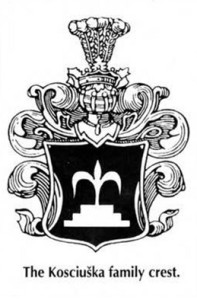
 DRAUGAS NEWS Lithuanian World Wide News in English
DRAUGAS NEWS Lithuanian World Wide News in English
